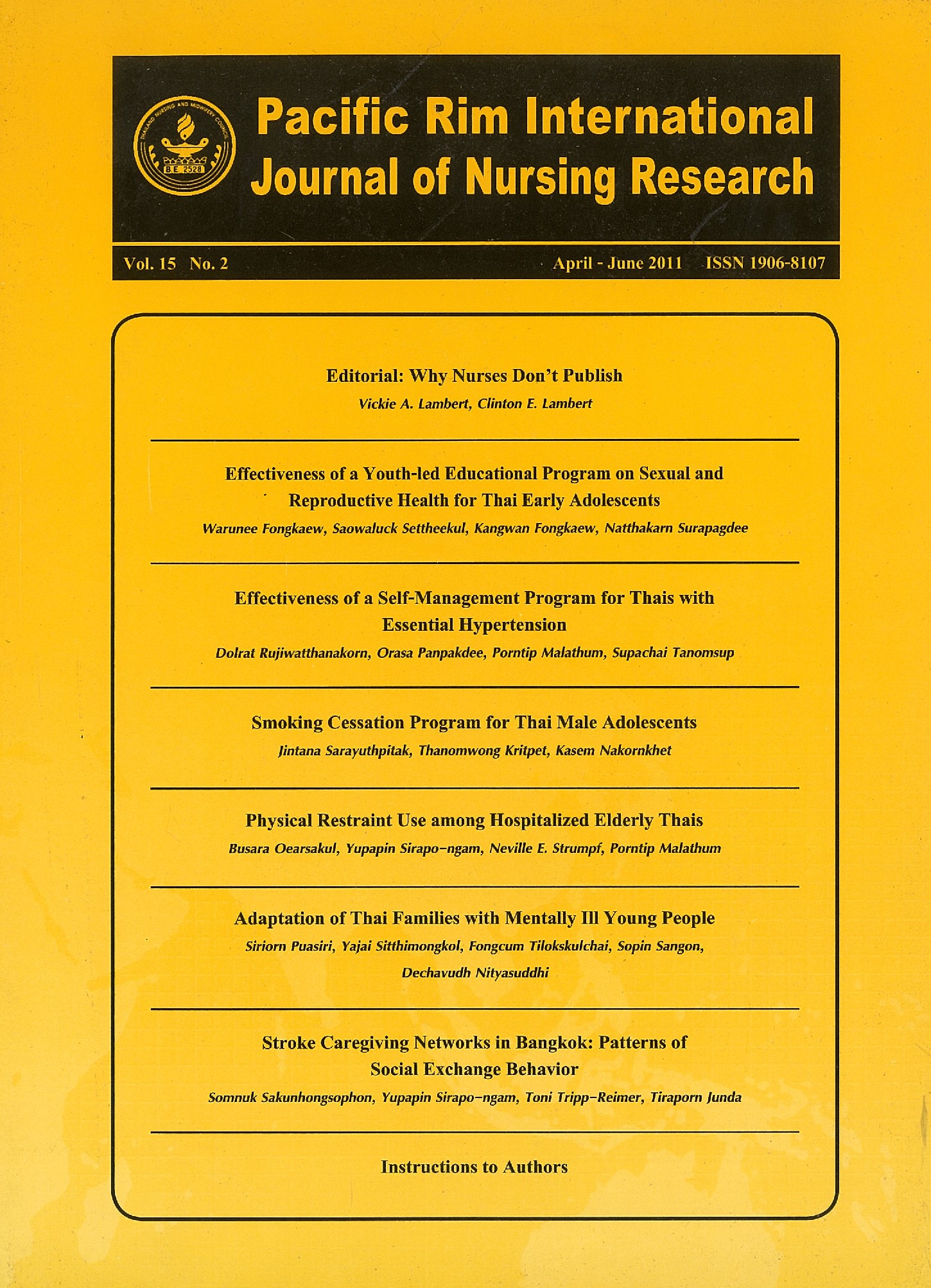Stroke Caregiving Networks in Bangkok: Patterns of Social Exchange Behavior
Keywords:
เครือข่ายการดูแล, อัมพาตจากหลอดเลือดสมอง, การแลกเปลี่ยนการช่วยเหลือทางสังคม, Caregiving network, Stroke caregiving, Social exchangeAbstract
บทคัดย่อ
การศึกษาครั้งนี้มีวัตถุประสงค์เพื่ออธิบายรูปแบบการช่วยเหลือทางสังคมของเครือข่าย ผู้ดูแลผู้ป่วยอัมพาตจากหลอดเลือดสมองในกรุงเทพ แนวคิดเครือข่ายทางสังคมนำมาช่วยในการศึกษาเครือข่ายความสัมพันธ์ระหว่างกัน และทฤษฎีการแลกเปลี่ยนทางสังคมนำมาช่วยในการศึกษาการแลกเปลี่ยนความช่วยเหลือในเครือข่ายผู้ดูแลผู้ป่วยอัมพาตจากหลอดเลือดสมองจำนวน 18 เครือข่าย ผู้ป่วยอัมพาตสูงอายุในกรุงเทพมหานคร ผู้ให้ข้อมูลสำคัญจำนวน 42 คนคือผู้ดูแลหลักจำนวน 22 คน และสมาชิกเครือข่ายจำนวน 20 คน การศึกษาครั้งนี้เป็นการวิจัยเชิงชาติพันธุ์วรรณา (Ethnographic study) เก็บข้อมูลโดยการสังเกต การสัมภาษณ์แบบเจาะลึกและการพูดคุย การบันทึกและวิเคราะห์เครือข่ายระหว่างเดือนมกราคมถึงเดือนกันยายน 2551 การวิเคราะห์บริบทของข้อมูลตามขั้นตอนของ Lecompete และ Schensul โดยใช้ Nvivo software program.
ผลการศึกษาพบรูปแบบการช่วยเหลือทางสังคมในเครือข่ายผู้ดูแลผู้ป่วยอัมพาตจากหลอดเลือดสมองในบริบทกรุงเทพฯเป็น 3 รูปแบบคือ การแบ่งกันดูแล (Sharing care) การร่วมกันดูแล (Dual care) และการสนับสนุนการดูแล (Supplementary care) ปัจจัยที่เกี่ยวข้องประกอบด้วยการสื่อสาร ขนาดเครือข่าย ระยะเวลา เวลาที่ให้ในการดูแล การเงิน สัมพันธภาพและความพึงพอใจ
คำสำคัญ : เครือข่ายการดูแล, อัมพาตจากหลอดเลือดสมอง, การแลกเปลี่ยนการช่วยเหลือทางสังคม
Abstract
This exploratory, descriptive, ethnographic study of 22 primary caregivers and 20 non-primary caregivers, who comprised 18 caregiving networks, sought to describe stroke caregiving networks and patterns of caregivers’ social exchange behaviors that influenced stroke caregiving. The concept of social network, in conjunction with social exchange theory, was used to describe relationships within the caregiving networks. Data were collected, January-September 2008, through a demographic data sheet, in-depth interviews and observations, household assessment, geographic mapping and network analysis. Data analyses were carried out via descriptive statistics and context analysis, using the method outlined by Lecompte and Schensul.
The findings revealed factors associated with the caregiving networks were: size (structural); communication (informational); duration and time (social); finances (financial); and, relationships and satisfaction (psychological). In addition, three major patterns of social exchange behavior were noted: (a) sharing care, in which care functions were divided among the primary caregiver and non-primary caregivers; (b) dual care, wherein care functions were delivered by two primary caregivers, along with non-primary caregivers; and, (c) supplementary care, whereby the primary caregiver, often a spouse, performed caregiving alone or with occasional support from non-primary caregivers.
Keywords : Caregiving network, Stroke caregiving, Social exchange
Downloads
How to Cite
Issue
Section
License
Copyright: The Pacific Rim International Journal of Nursing Research, Thailand Nursing & Midwifery Council has exclusive rights to publish, reproduce and distribute the manuscript and all contents therein.








.png)



